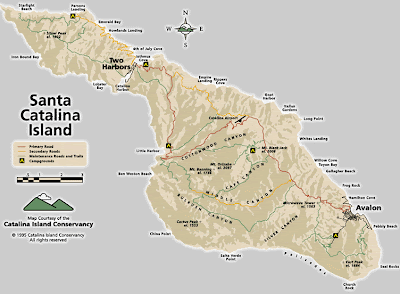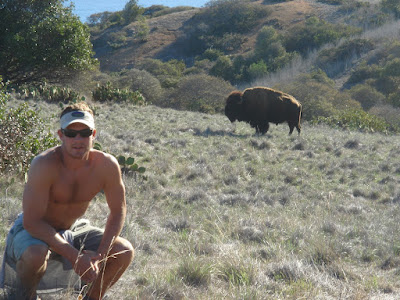Santa Catalina Island is about 22 miles long, rarely more than 5 miles across, and has a resident population of about 3,000. While around 1 million people visit the island each year most never travel beyond Avalon, its only significant town. About 15 miles northwest of Avalon along the coast is the port of Two Harbors, which with a robust population of 298 residents, is the second most populous settlement on the island. The bay at Two Harbors juts inland a significant distance slimming the island briefly into a "neck" section. North of the neck the land widens to from the Northwestern "head" section of the island, which with its manageable size and remote location Laura and I choose to camp in and explore.
Laura and I took the ferry directly to Two Harbors and rented two kayaks, loaded them up with our camping gear, and spent our first afternoon paddling 5 miles up the coast to Parson's Landing, an uninhabited beach campground just shy of the island's western apex. We camped at here all three nights. Amazingly, despite being less then 25 miles from greater Orange County and its 10 million inhabitants, we were totally alone our first two days and got to enjoy the beachfront in the absolute peace and solitude usually only provided by remote wilderness.

Laura on the beach at Two Harbors where we rented the kayaks

Laura on the beach at Two Harbors where we rented the kayaks
Parson's Landing not only offered refreshing afternoon swims, picturesque ocean vistas, and camping right on the sand but also clean toilet facilities, which were set back behind the beach camping area. You make reservations and get a permit to camp at Parsons at the Ranger station in Two Harbors and when you reach the site (either via a backcountry hiking trail or via kayak) that $12 permit also provides you a combination to a locker which contains 2.5 gallons of fresh water and a bundle of firewood. Not having to pack in all your fresh water, not having to search for firewood, and having access to restrooms are three luxuries which made the fact we had the site all to ourselves all the more remarkable.
View of Parson's Landing Beach from western edge ridge
Our two full days at Parsons followed a similar pattern. We woke up around 6:30 and read in our tent for an hour as the sun would not have yet risen above the eastern wall of the cove and the beach would remain cold in the non-direct morning light. As the sun emerged we made breakfast and ate it at the campsite's wooden table looking out across the ocean to California coast and trying to identify Hermosa Beach where we had been living the previous two months. Around 8:00 on both days we went on a hike; one up the coastand the otherup to the trans-Catalina trail along the mid-island ridge from which we could see the ocean on both sides of the island. While hiking the first day we saw the deposited evidence of Catalina's buffalo population which we had read about in a blurb on our trail map. After being transported to the island for the filming of a movie during the 1920s, the buffalo had been left and survived as a resident herd. On the second hike we turned a corner and found one of these magnificent American Bison (what a "Buffalo" really is) munching on his grass breakfast out in the sun.
Hunched before my buddy the Bison
After the hikes we returned to our campsite for a snack and then some swimming. Catalina's coast is known for its kelp forest ecosystem which is the home to a wide variety of aquatic life. The protected cove at Parson's landing was no exception. Kelp is an underwater sea plant which grows anchored to rocks on the seabed and stretches upward along a thick stalk with broad bushy leaves. Giant kelp "trees" have been known to reach from 250 feet down at the ocean bed all the way to the surface.
The kelp tree forests around Catalina where we did most of our swimming and diving ranged from the shallows of 8 feet to depths of perhaps 60. Swimming amongst the kelp and seagrass covered rocks we saw numerous fish- perch, bass, opaleyes. giribaldis, barracuda, and massive schools of small anchovies and topsmelt called "baitballs". We also saw bat rays, guitarfish, jelly fish, star fish, sea urchins, and most magnificently a four foot leopard shark.
Diving down, weaving the underwater forest, and then looking up for a break in the tangled kelp masses to navigate to and surface through was an otherworldly experience. The underwater world is remarkably still and quiet, seemingly suspended in a smooth blue medium which absorbs both sound and movement. The green colors of the kelp, ranging from florescent slime to deep forest depending on the light, stand out against the blue. Along the bottom rocks provide blue-grays and purples, with large ones rising to create walls teaming with aquatic life and covered in whitish sea grasses. Amidst this forest are patches of pure white sandy bottom with nothing growing which occur seemingly at random. Here the water is a lighter, brighter blue as the lack of kelp covering at the surface allows the sun to shine right through it.
A black and white polka-dotted starfish
It was in this world thatLaura and I would snorkel in the afternoons after our hike. The water temperature was around 65 and we both wore wetsuits and weightbelts to stay down when diving. I also swam with a pole spear, which is simply a 5 foot long aluminum shaft with a sharp tip propelled by a heavy rubber band loop which is attached to its base. By grabbing the rubber band loop by its free end, pulling it up and holding it at the top of the spear, the stretched band creates a lot of tension wanting to propel the shaft forward. When you release the shaft the tensed band anchored to the spears base shoots the spear forward as it contracts.
I had just bought my polespear and the Catalina trip was my first chance to try my hand at free-dive spearfishing. The primary targets are large kelp bass, a fish called sheepshead, and halibut which live along the bottom like flounder but are very hard to spot. Around Parson's I did not see many of these particular gamefish (I did see some bass but they were small). I did, however, hone my skills by shooting some larger perch, opaleye, and a bottom dwelling ray-like fish known as the guitarfish.
I had just bought my polespear and the Catalina trip was my first chance to try my hand at free-dive spearfishing. The primary targets are large kelp bass, a fish called sheepshead, and halibut which live along the bottom like flounder but are very hard to spot. Around Parson's I did not see many of these particular gamefish (I did see some bass but they were small). I did, however, hone my skills by shooting some larger perch, opaleye, and a bottom dwelling ray-like fish known as the guitarfish.
Spearing the guitar fish right in front of my sister was probably a funny site. I had noticed three large fish laying flat along the bottom and at first had hoped they were halibut. The seemed too ray like- with their wide triangular heads and long tails- however, I did not want to take a chance and miss a tasty kill. I pulled my spear band tight, dived down to about 15 feet where I knew my shot would reach them, and then, hoping for the best, let go. The fish shot up off the bottom thrashing at the end of the tri tipped spear sending my arm, which still gripped the spear's base, into wild undulations. The tips had gone through the fish's large flat head but it did not appear to be rapidly dying. I remembered the advice from the guy who had sold me the spear, and reached down for the dive knife strapped to my calf. After struggling to free the knife from its sheaf, and trying to ignore my bodies increasing insistence to surface for air, I pulled the speared fish towards me and delivered two knife stabs below the its eyes. Its thrashing stopped and I swam up and broke the surface. Laura was waiting for me up there a bit wide-eyed but laughing at the whole scene.
As I mentioned the fish did not end up being halibut, but instead a guitarfish which was indeed a member of the ray family. Luckily, however, the fish/ray's tail yielded some meaty filets, which after some googling on my blackberry (all of Catalina has cell coverage) were found to be edible. We cooked the fish over an open wood fire along with the perch and served it with rice for dinner.
When not swimming and hiking, we spent our downtime at Parson's campsite reading, napping, and- for Laura- painting in the cool beach cove. The wooden table provided a great platform for her to do her water color paintings from. While she painted, I slept or read the biography of Ghengis Khan I had brought along. At night after dinner we built a fire on the beach and sat out under the stars before bed.
View looking over our tent at sunset
We left Parson's beach on the third day and paddled back to Two Harbors to catch our ferry. The afternoon before we had been joined by two other sets of backpackers who had arrived at the campsite from the trail. We felt lucky to have had the site to ourselves and were happy to share the beach that night and leave it to them the next day. At least a few other people in the vast expanse of greater LA area had recognized that such a magical spot existed right under their nose.








No comments:
Post a Comment